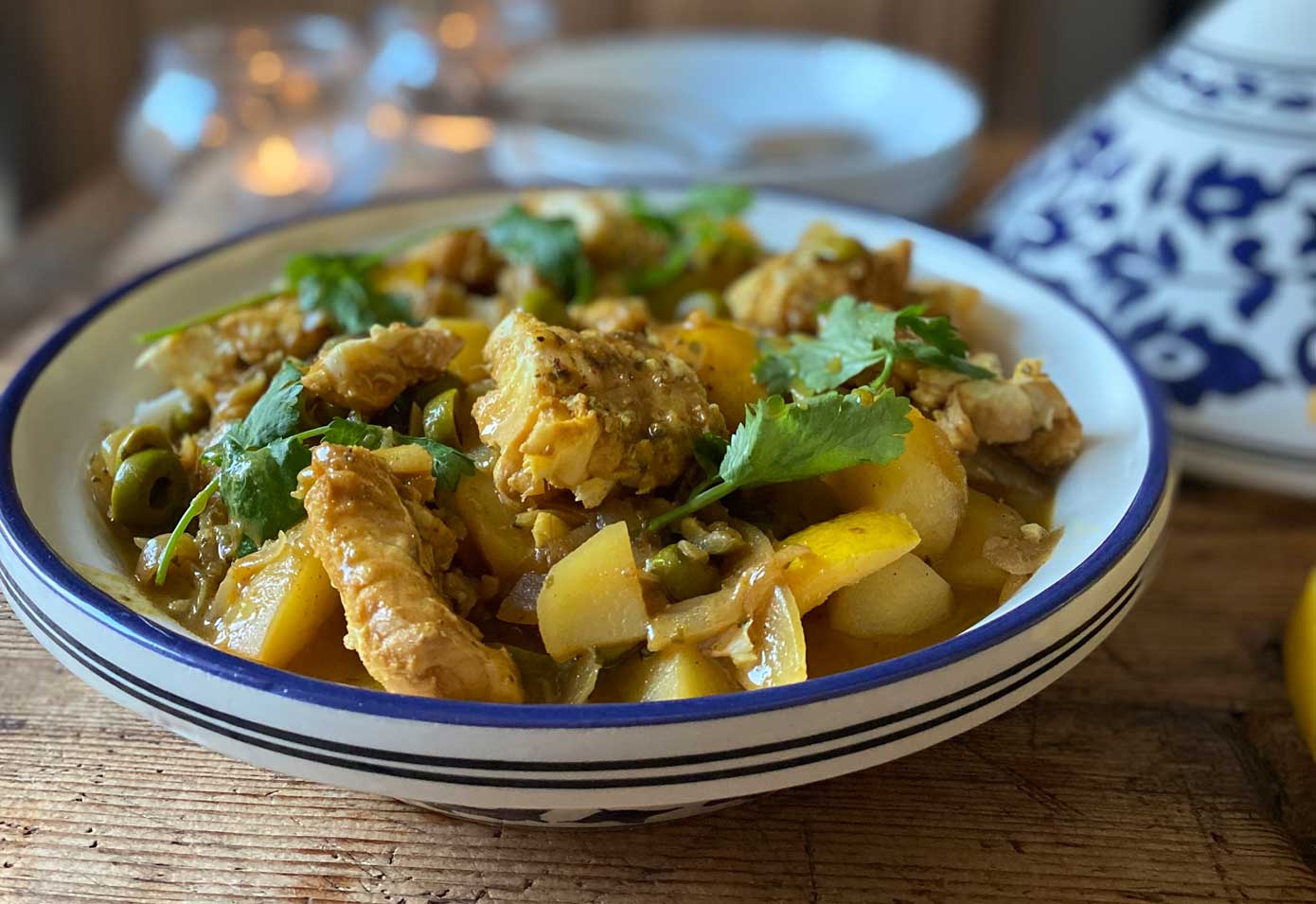Trish Deseine gets in the swim of things …
As I head happily indoors this autumn, craving more than ever the cosiness of a warm kitchen, I’m trying to switch up my non-meat protein intake to include more fish – but without exploding my already dwindling food budget. For years, I would buy my haul from markets in or near Paris, supplied either directly from Normandy boats or via the massive machine that is international wholesale market, Rungis, the second largest in the world. It was always spanking fresh, or in the case of some seafood items, still alive, and I never had to do very much to it. Simple grilling, steaming or roasting with some subtle citrus or aromatic flavours, good salt, olive oil or butter was always enough. In French home and bistro cooking, a relatively plain hunk of fish protein, like meat, is usually central to a dish. Its raw freshness is key to the success of its cooked texture and therefore, the recipe, and as long as you get the timing right, it’s hard to go wrong.
But since I’ve been living in the more remote region of la Sarthe, procuring decent, reasonably priced fish has been much more problematic. Whole fish are scarce on fishmongers’ market displays, and the choice often limited. And as for the supermarkets, vac-packed pieces are invariably woolly and, infuriatingly, slightly salted, just one notch up from sodden frozen versions (I’d rather just have a boiled egg, thanks). Increasingly, I’ve been obliged to relegate a dish’s fishy role from diva to choir member.
This has been fun! It has regularly taken me away from à la minute classic French recipes and into North African, Eastern Mediterranean, Spanish and Portuguese cuisines where fish and seafood merge and meld with other textures and tastes, adding heft and umami just like slowcooked meat would do, only faster. Moving into an energy-conscious winter, sun-filled, nutrientdense, fish-forward recipes prep easily, cook quickly and are bursting with rich flavours.
I draw the line, as ever, at multi-step, fiddly “weekend project” dishes such as bouillabaisse, where the integrity of original, local components is absolutely vital. It’s no good tweaking or using shortcuts if you do not have access to poissons de roche for the famous fish broth, or the correct type of fresh octopus to stuff rich Languedocien pies. Instead, I have embraced salted cod, which feels to me like the foodstuff of the moment. Not meat, cheap and plentiful, easy to store, full of vitamins and, magically, swelling to three times its size once properly soaked, it is a beautifully versatile ingredient. For me, perhaps the best thing about salt cod is how wonderful it is cooked alongside potatoes. Think French brandade de morue, (a sort of garlicky, creamy, fishy mash if you do not yet know and love it) or salt cod and potato fritters from the Caribbean and Portugal, where salt cod is the name and main ingredient of several of their national dishes.
The grilled, dark flesh of fresh tuna is of course a great natural replacement for a sirloin steak, but I also love how it holds up to an hour or so’s casserole simmer, jiggling along with tomatoes, peppers, wine and feisty Basque spice in thon à la Basquaise. Portugal also gives us the wonderful arroz de marisco, paella’s more chilled-out cousin, a brilliantly thrifty yet festive rice dish, which uses the robustly flavoured cooking juices of prawns, clams and mussels to infuse the rice. The result is a much looser, brinier base – think risotto rather than more stodgy paella – and here, you can tweak the broth or the seafood content to your heart’s content. I like to make things simpler with store-bought fish stock rather than boiling prawn shells, and by leaving out clams, for example. But I do love adding some fresh crabmeat and samphire to top, when I can get hold of them.
For a chic winter starter that won’t break the bank, I make the most of mussels’ intense flavour by steaming free their wine-soaked juices and then blitzing them (shelled!) into creamy soup, gently spiced with saffron and a hint of cumin. And an easy, economical way to cook cheaper white fish fillets – haddock, whiting, tilapia – is in a 1970s retro terrine, laced with cream, eggs, tomatoes and other vegetables, and served cold with a herb mousseline or warm with an indulgent hollandaise. @TrishDeseine @trishdeseineencore

Fish Tagine with Preserved Lemons
This is a perfect example of how we can cut cooking times using fish rather than meat as most of the flavour action will happen in the fridge, at the marinating stage. You can leave out the potatoes, and/or bump up the vegetable content with a mix of carrots, courgettes and peppers. The preserved lemons give beautifully aromatic notes. Adjust the chilli heat as you like: I find a gentle background best, so it does not overpower the rest of the flavours.
For 6
4 hours marinating
30 minutes cooking
If you have an ovenproof (non varnished/patterned) tagine dish, its time has come! Otherwise use a heavy-bottomed pan with a snug lid on the hob, or a clay oven dish and lid in the oven.
• 800g cod fillets (or hake, or other firm white fish) • 600g waxy potatoes • 150g pitted green olives • 2 cloves garlic, peeled, crushed into a paste • 3 onions • Juice of 2 lemons • 1 preserved lemon, pips and pith removed, chopped • 2–3 tsp Moroccan spice mix or a mix of ground cumin, ginger, coriander and curcuma • 5 tbsp olive oil • Pinch of chilli pepper of your choice • Lemon, flat leaf parsley and coriander to garnish
1. To make the marinade, peel and crush the garlic into a paste. Mix the lemon juice with the garlic, pepper, spices, 4 tbsp olive oil, chilli and a little salt. Marinate the fish in this mixture in a Pyrex dish covered with film. Place in the fridge for 4 hours.
2. Heat the oven to 165°C (if not cooking on the hob).
3. Peel and chop the potatoes and onions. Heat the remaining oil in a pan and sauté the onions for a few minutes until browned.
4. Remove the fish from the marinade and reserve the marinade.
5. Add the olives, preserved lemon and potatoes to the pan, drizzle with the marinade juices and cook for a few minutes on low heat, to let the ingredients and flavours mingle.
6. Now add the fish, stir once or twice, carefully leaving the fish in chunks, then add water to barely halfway up the level of the ingredients.
7. Cover the pan, and cook in the oven or simmer/steam for 25 minutes over a low heat, stirring and checking a couple of times.
8. Check the seasoning and serve hot, garnished with lemon wedges, coriander and parsley.
LOVETHEGLOSS.IE?
Sign up to our MAILING LIST now for a roundup of the latest fashion, beauty, interiors and entertaining news from THE GLOSS MAGAZINE’s daily dispatches.





